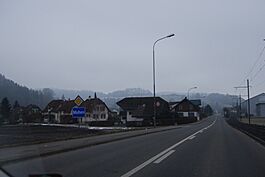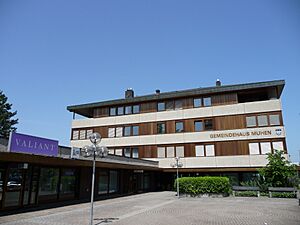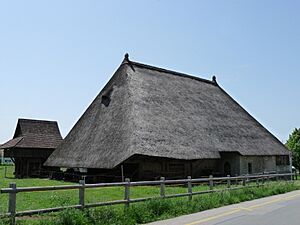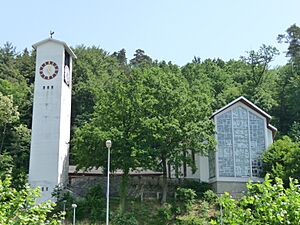Muhen facts for kids
Quick facts for kids
Muhen
|
||
|---|---|---|
 |
||
|
||
| Country | Switzerland | |
| Canton | Aargau | |
| District | Aarau | |
| Area | ||
| • Total | 7.03 km2 (2.71 sq mi) | |
| Elevation | 433 m (1,421 ft) | |
| Population
(Dec 2020 )
|
||
| • Total | 3,985 | |
| • Density | 566.9/km2 (1,468.2/sq mi) | |
| Postal code |
5037
|
|
| Surrounded by | Gränichen, Hirschthal, Holziken, Kölliken, Oberentfelden, Unterkulm | |
Muhen is a small town, also called a municipality, in Switzerland. It is located in the Aarau district within the canton of Aargau.
Contents
History of Muhen
Muhen was first mentioned in old documents in 1045. At that time, it was called Mucheim. Later, in 1267, its name was written as Mukhein.
Geography and Landscape
Muhen covers an area of about 7 square kilometers (2.7 square miles). A large part of this land, about 42.6%, is used for farming. Forests cover another 42.2% of the area.
About 15.1% of the land is developed with buildings and roads. A very small part, 0.1%, consists of non-productive areas like rivers or lakes.
The municipality is located in the lower Suhr valley, which is part of the Aarau district. Muhen is made up of several villages that have grown together over time. These include Obermuhen, Mittelmuhen, Untermuhen, and Schwabistal.
Muhen's Flag and Coat of Arms
The official design of Muhen's flag and coat of arms is quite special. It features a blue background. At the bottom, there are wavy lines that look like water. Above these lines, there is a bridge. At the top of the design, you can see two golden stars.
Population and People
Muhen has a population of about 3,985 people. About 12.1% of the people living in Muhen are from other countries. Over the last 10 years, the population has grown by about 12.9%.
Most people in Muhen speak German, which is 93.5% of the population. Italian is the second most common language, spoken by 3.1% of residents. French is spoken by 0.7% of the population.
In 2000, there were many different types of households in Muhen. About 60 homes had 1 or 2 people living in them. There were 522 homes with 3 or 4 people, and 557 homes with 5 or more people. On average, each household had about 2.51 people.
Education in Muhen
Education is important in Muhen. About 75.1% of the adults (aged 25-64) have completed higher education. This means they have either finished advanced secondary school or gone on to university.
In the 2008/2009 school year, 222 students attended primary school in Muhen. Additionally, 115 students attended secondary school within the municipality.
Here is a look at how Muhen's population has changed over time:
| Historical population | ||
|---|---|---|
| Year | Pop. | ±% |
| 1764 | 615 | — |
| 1803 | 846 | +37.6% |
| 1850 | 1,288 | +52.2% |
| 1900 | 1,213 | −5.8% |
| 1950 | 2,046 | +68.7% |
| 2000 | 3,083 | +50.7% |
Historical Buildings and Heritage
Muhen once had a special 17th-century farmhouse with a thatched roof and a barn. This building was recognized as an important national heritage site in 1995. However, it was later removed from the list of national heritage sites in 2008.
Economy and Jobs
In 2007, Muhen had a low unemployment rate of 1.15%. This means most people who wanted to work had jobs.
The economy of Muhen is divided into three main parts:
- Primary Sector: This includes jobs like farming. In 2005, 96 people worked in this sector, with 31 businesses.
- Secondary Sector: This involves manufacturing and construction. There were 282 people employed in this sector, working for 36 businesses.
- Tertiary Sector: This covers services, like shops, offices, and healthcare. This was the largest sector, with 882 people working in 84 businesses.
Many people who live in Muhen travel to other towns for work. In 2000, about 78% of the working residents commuted outside Muhen. However, 418 people also came into Muhen to work. Overall, there were 760 jobs available in the municipality itself.
Religion in Muhen
According to the 2000 census, most people in Muhen belong to one of two main Christian faiths. About 20.2% of the population are Roman Catholic. A larger group, 64.6%, belong to the Swiss Reformed Church. A very small number of people, about 0.23%, are part of the Christian Catholic faith.
See also
 In Spanish: Muhen para niños
In Spanish: Muhen para niños








